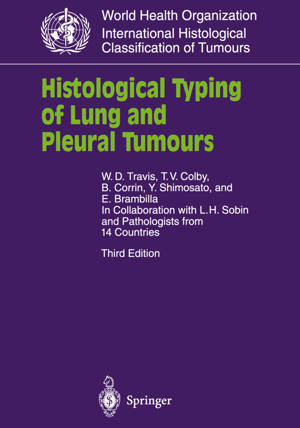
- Afhalen na 1 uur in een winkel met voorraad
- Gratis thuislevering in België vanaf € 30
- Ruim aanbod met 7 miljoen producten
- Afhalen na 1 uur in een winkel met voorraad
- Gratis thuislevering in België vanaf € 30
- Ruim aanbod met 7 miljoen producten
Zoeken
Histological Typing of Lung and Pleural Tumours
W D Travis, T V Colby, B Corrin, Y Shimosato, E Brambilla
€ 84,45
+ 168 punten
Omschrijving
Lung cancer is currently the most frequently diagnosed major cancer in the world and the most common cause of cancer mortality world- wide. This is largely due to the carcinogenic effects of cigarette smoke. Over the coming decades, changes in smoking habits will greatly influ- ence lung cancer incidence and mortality throughout the world. These changes may also impact upon the histological types of lung cancer. Tumour classification is important for consistency in patient treat- ment, and because it provides a basis for epidemiologic and biologi- cal studies. The previous WHO classification was published in 1981 and since then considerable progress has been made in our understanding of cer- tain lung tumours 1. The concept of neuroendocrine tumours of the lung has been refined with recognition of large cell neuroendocrine carci- noma and modification of criteria for atypical carcinoid. Atypical ade- nomatous hyperplasia is now recognized as a potential precursor to adenocarcinoma. Studies have documented the histological hetero- geneity of lung carcinomas, particularly among adenocarcinomas and poorly differentiated carcinomas. Molecular studies have also shown that hamartomas and sclerosing hemangiomas are true neoplasms rather than tumour-like lesions. This classification is based on histological characteristics of tumours seen in surgical or needle biopsy and autopsy material. Though a large percentage of lung carcinomas are now diagnosed on cytology specimens, the classification does not address cytology.
Specificaties
Betrokkenen
- Auteur(s):
- Uitgeverij:
Inhoud
- Aantal bladzijden:
- 156
- Taal:
- Engels
- Reeks:
Eigenschappen
- Productcode (EAN):
- 9783540652199
- Verschijningsdatum:
- 23/04/1999
- Uitvoering:
- Paperback
- Formaat:
- Trade paperback (VS)
- Afmetingen:
- 170 mm x 244 mm
- Gewicht:
- 290 g

Alleen bij Standaard Boekhandel
+ 168 punten op je klantenkaart van Standaard Boekhandel
Beoordelingen
We publiceren alleen reviews die voldoen aan de voorwaarden voor reviews. Bekijk onze voorwaarden voor reviews.











